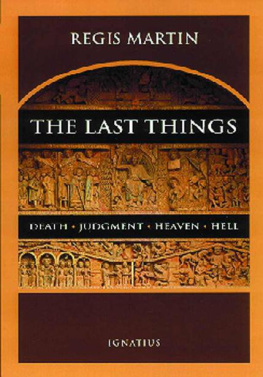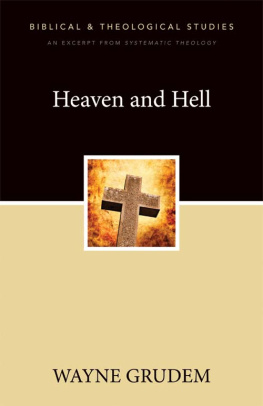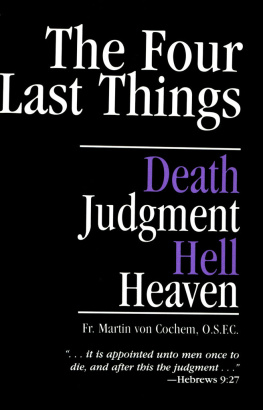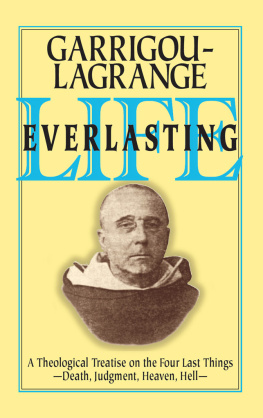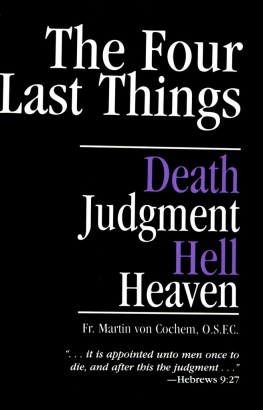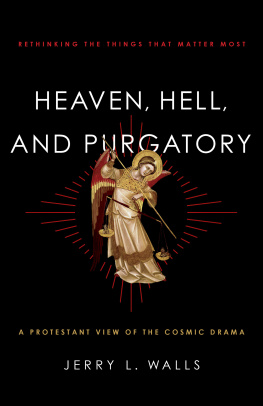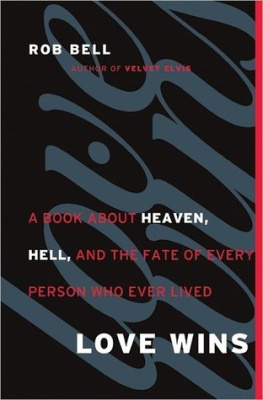The Last Things
REGIS MARTIN
The Last Things
Death
Judgment
Hell
Heaven
IGNATIUS PRESS SAN FRANCISCO
Cover art:
Tympanum showing Last Judgment
Abbey Ste. Foy. Conques, France
Scala / Art Resource, NY
Cover design by Roxanne Mei Lum
1998 Ignatius Press, San Francisco
All Rights Reserved
ISBN 0-89870-662-9
Library of Congress catalogue number 97-76855
Printed in the United States of America
In memory of my mother,
Elizabeth Naomi Martin,
who first introduced me
to the Last Things
Question: What are the Four Last Things to be ever remembered?
Answer: The Four Last Things to be ever remembered are Death, Judgment, Hell and Heaven.
The Penny Catechism
Prayer for a Good Death
O merciful Christ, omnipotent judge of the universe and all creatures within it, I know that someday I shall stand before you to render an account of all that I am and have done. Grant me the grace to gird my mind and will to face that fearful summons; to fortify myself at all times with the grace of a good life; to persevere to the end amid the holy ministrations of Mother Church. Preserve me and all your children from a sudden and unprovided death. Send your angels and saints to hover about us at the last, lest the Evil One entice us to despair of your mercy and protection. Saint Joseph, Patron of a Good Death, be with me in my final agony; give me comfort and solace in the midst of pain, to long for and await my Redeemers deliverance. I ask you this through Christ our Lord. Amen.
Contents
Preface
Well, Harriet, what do we do next? I think weve seen everything now.
It was more than ten years ago in Rome when, coming out of a cappuchino bar, I overheard the two of them talking on the sidewalk. It was too good to pass up (and I thought Id seen everything!). Here were a prize pair of blooming innocents from the New World, at the end of their first full day in Rome, whose charms, as every artist will tell you, are akin to falling in love, and wouldnt you just know it, theyd already picked the place clean.
I resisted asking any of the usual questions, the ones whose answers are all too easily turned to ridicule. Oh, the Colosseum? Sure, weve seen it. Just great. Whens it gonna be finished? Or the exchange that, so help me, I once overheard in the depths of the catacombs of Saint Domitilla between two Americans of indeterminate age, neither of whom could be certain whether the construction date on the tunnels was B.C. or A.D. I kept my own counsel then; this time a droll impulse took hold, and I spoke.
Had they seen, I asked, Santa Maria della Concezione? No, they hadnt. Well, its quite extraordinary, you know: a Capuchin church, located right at the bottom of Via Veneto...
Oh, now, weve certainly been there!
It was all that Id feared. Via Veneto, yes. Everyones been there. Romes most glittering showcase, the place where the rich and famous once disported themselves and where, alas nowadays, only tourists, armed with credit cards and cameras, abound. Yes, theyd been to Via Veneto. In fact, their tour was staying nearby, and so theyd seen all the sights: Harrys Bar, the restaurants replete with American fast food, the boutiques, the discos, and all the news they had gone two whole days without.
Whats so special about this Santa place, huh?
It is full of dead mens bones, I said. Try and think of it as the surprise stop on the tour. You know, the place theyd forgotten to schedule.
They left pretty quickly after that, muttering and shaking their heads in disbelief. How long, I could just hear him telling Harriet, how long has he been left out in the sun?
I cant help it: Santa Maria della Concezione is just about my favorite place in the whole world. Indeed, were I to have guided their tour bus through the Eternal City, Id have driven straight from the airport to this splendid house of the dead, where clever Capuchin friars have piled high their crypt (four subterranean chapels, no less!) with the skeletal remains of four thousand souls who were once like thee and me.
Such a hugely funny joke, too, to have situated the whole overflowing Memento mori right at the foot of fashionable Via Veneto, as if to serve notice on the worldly that they too shall come to an end. Admittedly, Santa Maria della Concezione hasnt any of the sparkle and glitter that so beguile the visitor, ineluctably drawn to La Dolce Vita further up the street. But unlike the fleshpots, of which, lets face it, after twenty or so minutes the palate wearies (it is, after all, only the allure of the veneer that arrests the senses), one is free to wander down to the Capuchin crypt and there begin a most lively scrutiny of Death. Where one confronts firsthand the stark, unmediated truth about oneself, and others, and the world. The truth that all is vanity, destined soon enough to wither like the grass.
Do tell me what you think of life, a woman asked of Henry James. I think, replied the master, it is a predicament which precedes death. The first of the Four Last Things ever to be remembered, Death is a subject about which we can never say enough. And when we begin to think wisely and well of Death, it soon follows that the other threenamely, Judgment, Hell, and Heavenare very likely to invite fruitful inquiry as well. Even tourists would do well to remember the Last Things. For it is not wellno, not even for tourists, whose vacation lives suggest something of the character of all lives (a state of parenthesis between time and eternity)to forget the End.
I offer these reflections, for whatever they may be worth, in memory of my mother, who first awakened in me an interest in the Last Things.
On the Last Things
Try to imagine the one thing in this world that is most worth knowingby everyone. The thing that is most worth having. Something the sheer longing for which could never be dismissed merely as a function of time or space, tribe or temperament. Is there a sentient being around who has not felt it, wondered about it, made some effort to obtain it? Could it have something to do with the final outcome of our lives? Or the lives of those whom we love? Lives no longer with us but lost, whom we long once more to see, to be with. What does Christianity offer us in this regard? Has the Church anything distinctive to say about it? And if so, can it assuage this most deep and persisting of human hungers?
The answers to these questions, and a clutch of others besides, are to be found in the Churchs doctrine of the Last Things. Eschatology , which is a term deriving from the Greek word eschata , meaning outcomes or ends, is very simply the fruit of the Churchs most profound reflection on the meaning of Death, Judgment, Hell, and Heaven (also Purgatory, Limbo, the Second Coming of Christ, and the End or Transfiguration of the World).
Traditionally referred to as the Four Last Things , these are the mysteries that bear most directly on the final section of the Creed, namely, the resurrection of the body, and life everlasting, the loftiest realities to which Christian belief may be expected to aspire. We seek the city that is to come, declares the author of the Letter to the Hebrews.
But what a strangely perverse silence fills the air the moment the subject is brought up! Is it not matter for astonishment that while all the ancient peoples incessantly reflected on the nature of the next world, having wisely intuited the impermanence of this passing one, hardly any self-respecting modern appears the least bit interested in the hereafter? How seldom, for example, modern man thinks of death, an event that, after all, represents the real point of entry into eternity. Respice finem , which means look to the end, is an ancient pagan motto whose message the Christian religion early on embraced. Indeed, Jesus himself enjoined his disciples to watch and wait, mindful of the End: Therefore you also must be ready; for the Son of man is coming at an hour you do not expect.
Next page
